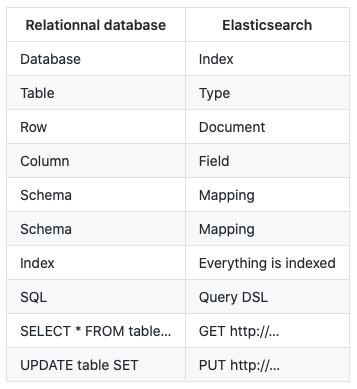Python Elasticsearch DSL 查询、过滤、聚合操作实例

Elasticsearch 基本概念
Index:Elasticsearch用来存储数据的逻辑区域,它类似于关系型数据库中的database 概念。一个index可以在一个或者多个shard上面,同时一个shard也可能会有多个replicas。
Document:Elasticsearch里面存储的实体数据,类似于关系数据中一个table里面的一行数据。
document由多个field组成,不同的document里面同名的field一定具有相同的类型。document里面field可以重复出现,也就是一个field会有多个值,即multivalued。
Document type:为了查询需要,一个index可能会有多种document,也就是document type. 它类似于关系型数据库中的 table 概念。但需要注意,不同document里面同名的field一定要是相同类型的。
Mapping:它类似于关系型数据库中的 schema 定义概念。存储field的相关映射信息,不同document type会有不同的mapping。
下图是ElasticSearch和关系型数据库的一些术语比较:

Python Elasticsearch DSL 使用简介
连接 Es:
先看一下搜索,q 是指搜索内容,空格对 q 查询结果没有影响,size 指定个数,from_ 指定起始位置,filter_path 可以指定需要显示的数据,如本例中显示在最后的结果中的只有 _id 和 _type。
查询指定索引的所有数据:
其中,index 指定索引,字符串表示一个索引;列表表示多个索引,如 index=["bank", "banner", "country"];正则形式表示符合条件的多个索引,如 index=["apple*"],表示以 apple 开头的全部索引。
search 中同样可以指定具体 doc-type。
根据某个字段查询,可以多个查询条件叠加:
多字段查询:
还可以用 Q() 对象进行多字段查询,fields 是一个列表,query 为所要查询的值。
Q() 第一个参数是查询方法,还可以是 bool。
通过 Q() 进行组合查询,相当于上面查询的另一种写法。
过滤,在此为范围过滤,range 是方法,timestamp 是所要查询的 field 名字,gte 为大于等于,lt 为小于,根据需要设定即可。
关于 term 和 match 的区别,term 是精确匹配,match 会模糊化,会进行分词,返回匹配度分数,(term 如果查询小写字母的字符串,有大写会返回空即没有命中,match 则是不区分大小写都可以进行查询,返回结果也一样)
其他写法:
聚合可以放在查询,过滤等操作的后面叠加,需要加 aggs。
bucket 即为分组,其中第一个参数是分组的名字,自己指定即可,第二个参数是方法,第三个是指定的 field。
metric 也是同样,metric 的方法有 sum、avg、max、min 等,但是需要指出的是,有两个方法可以一次性返回这些值,stats 和 extended_stats,后者还可以返回方差等值。
最后依然要执行 execute(),此处需要注意,s.aggs 操作不能用变量接收(如 res=s.aggs,这个操作是错误的),聚合的结果会保存到 res 中显示。
排序
分页
一些扩展方法,感兴趣的同学可以看看:
参考文档:
http://fingerchou.com/2017/08/12/elasticsearch-dsl-with-python-usage-1/
http://fingerchou.com/2017/08/13/elasticsearch-dsl-with-python-usage-2/
https://blog.csdn.net/JunFeng666/article/details/78251788
版权声明: 本文为 InfoQ 作者【AlwaysBeta】的原创文章。
原文链接:【http://xie.infoq.cn/article/b956994e871e35a95b6f72b0a】。文章转载请联系作者。









评论